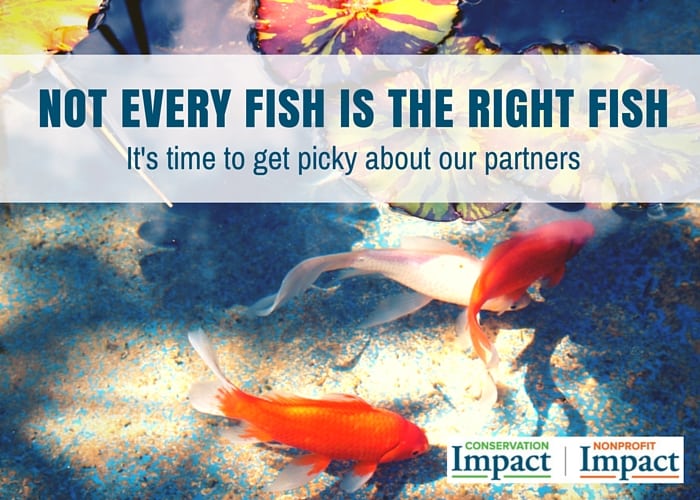
Plenty of Fish in the Sea
There are plenty of fish in the sea. Has a well-meaning friend ever said that to you after a break-up?
It’s true. There are a lot of fish out there. The problem is that some of us keep catching the same sort fish over and over again (okay, maybe I’m projecting). But often the issue isn’t quantity; it’s quality.
If we stop ruminating over our dating histories and start considering our partnerships, the quantity vs. quality issue rings equally true. Clients often tell us about partnerships that feel stuck about partners who fail to follow through; about partners who disappear when the funding dries up. If your partnerships aren’t all that you had hoped for, then it’s time to make a change.
First, what exactly are you hoping to catch?
Before you start packing up your fishing gear, answer these questions:
- What is the purpose of the partnership? What result do you expect?
- What role will your organization or agency play in the partnership?
- What role do you need the partner to play?
- What skills, abilities, knowledge, or access would your ideal partner have?
- What value are you willing to provide to your partner?
This pre-partnering reflection gets you started in the right direction. If you need a partner who is willing to invest money as well as time, then a financially unstable organization is not the right partner for you. If attaining the desired result requires a partner who can advocate for policy change, then you must seek out a partner who has a track record of advocacy success.
Next, pick the right fishing hole.
A little pre-partnering reflection can help you create a discrete list of potential partners who meet your criteria. If you want a truly strategic partnership – a partnership based upon attaining shared goals – then your next task is to vet potential partners for interest and fit. A long-term, productive partnership is based on mutual interest and creating real value for both parties.
Then, size up your catch.
A strategic partner relationship can’t be based on assumptions. You have to really get to know this new “fish” and see how it measures up. A discovery conversation is a great getting-to-know-you strategy.
A discovery conversation is a conversation that helps you discover the interests of your potential partner and assessing how well your two organizations might work together. Ideally, the conversation will help each of you see how and if your goals align and understand each other’s mission, strategic focus, and current challenges. Arranging a discovery conversation is as simple as picking up the phone, even if the potential partner does not know your organization. Pick up the phone and say some variation of:
I would like to meet with you for an hour to explore the possibility of our working together. I suspect we have some important goals and interests in common and want to find out if that’s true. I won’t be asking you for anything; this is an initial conversation only.
This is a meeting you should prepare for. Think of it as a first date with a potential long-term sweetie and make a good first impression. Create an agenda and prepare some questions that address the items you want to learn about. Some of my favorite questions for discovery conversations include:
- Tell me about your strategic goals and your key priorities for the coming year.
- What kinds of obstacles do you encounter in your work?
- What external factors most affect your ability to achieve your goals?
- How do decisions get made in your organization?
- How important is X in relation to your strategic goals?
- What are your needs and interests relative to X?
(X = the result you have in mind for the partnership)
A discovery conversation is not 20 questions; it is a two-way conversation. Be ready to answer the same types of questions you want to ask.
Decision time: throw them back or reel them in?
A single conversation may not be enough. Take as long as you need. Remember, there are a lot of fish in the sea, but only a few of them are right for you. If the interests don’t align (e.g., it’s mission-critical to you but just a “nice to have” to them) or you realize that the fit is off, thank them for their time and wish them well. Don’t settle when looking for a strategic partner. When it’s the right fish, the discovery conversation will let you know.

